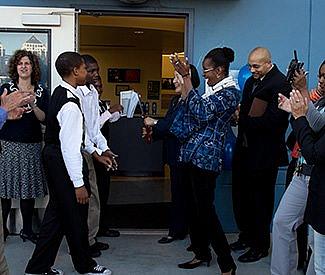School-based health centers gain funding, support in California

The number of school-based health centers has been growing in California for more than a decade, and the Affordable Care Act has boosted their funding. Through the federal health care reform law, school health centers in the state have received more than $30 million since 2011, according to this article by Kelley Weiss of the CHCF Center for Health Reporting (Here’s a list of what each state received for its own school health centers).
Serena Clayton, executive director of the California School Health Centers Association, told me in a phone interview last week, that school-based health centers accomplish many of the health care law’s goals. They enable students to access primary care services directly on their school campuses for little or no cost. They provide preventative, cost-effective care, and are easily accessed by students and their families.
“The need for that kind of service is going to be more and more important with health care reform,” Clayton said. “It’s a great opportunity for school-based health centers to play more of a role in the health care system.”
Currently in California, there are about 200 school-based health centers, and another 40 on the way, according to Clayton.
Given the momentum and promise of school-based health centers, I was interested to learn that some students served by these clinics also enthusiastically support them.
“I honestly think every high school should have a health center,” Victor Sigarán told me in a phone interview. He is a student at California State Polytechnic Pomona and a member of the California School Health Centers Association’s Youth Board, which advocates for student health issues.
As a student at John Marshall High School in Los Angeles, Sigarán underwent sports physicals at the campus health center. The center was a great resource for classmates who had limited transportation options, or wanted privacy when they received pregnancy or HIV tests, he said. It also offered students a safe place to talk with a health professional, he said.
Brenda Martínez, also a member of the Youth Board, has fond memories of John Marshall’s school health center, as well. Many lower-income students - herself included - could not afford to get all the necessary health services at a regular clinic, she said. But through the center, she easily received sports physicals, as well as flu shots and regular check-ups.
“The health center at my high school helped me so much to get regular check-ups done, because I couldn’t afford to go anywhere else,” said Martínez, who hopes to study nursing at California State University, Los Angeles. “I feel like they definitely should expand as much as possible.”
Clayton, of the California School Health Centers Association, said the experiences of Sigarán and Martínez illustrate the positive impacts these centers can have on students. The health centers offer health services to all students, and extra support and services to higher-risk students.
Still, there is room for these centers to grow. Clayton is interested in seeing more state funding for school-based mental health services. And Martínez, of the Youth Board, thinks more school health centers should offer dental services.
“I feel like that’s something that should be available,” Martínez said. “It’s so expensive to go to the dentist, and there are so many students who are not fortunate enough to be able to pay for the services they need.”
Image of West Oakland Middle School Health Center opening by Paloma Gracia, California School Health Centers Association

